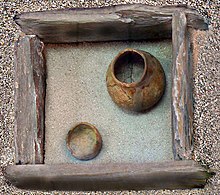Cista
A ciste or cista (Latin-Greek, our box ) is a type of round container that was used for various purposes.
The Cista mystica was woven from willow rods and contained the sacred implements used at the festivals of Bakchos and Demeter (see Eleusinian Mysteries ).
The cista is on monuments, e.g. B. on coins , especially on Asian Minor (see cistophores ), clay reliefs, also on the Naples colossal group of the Farnese bull , as a rule depicted half-open so that the sacred snake can slip out of it.
Cisten are also the small, cylindrical bronze containers that were made in Etruria , especially in Praeneste , for household use to store toiletries, and the sides of which are usually decorated with engraved figures, while small bronze figures are soldered onto the lid.
The Barberine Library in Rome contains the most important collection of such cists . The so-called Ficoronische Cista in Rome ( Villa Giulia (Rome) ) is particularly famous , on the side walls of which the rest of the Argonauts is depicted.
Another Cistenform in bronze are the so-called Rippenzisten whose cylindrical bodies are adorned with horizontally extending ribs. According to Berta Stjernquist, the type of carrying device divides them into a series I with fixed handles and a series II with movable handles, which can be traced back to different workshop circles. Rib cisterns can be found between the 7th and 4th centuries BC. From Northern Italy to Northern Europe. A manufacturing center is believed to be in Bologna.
The Etruscan, four-sided ashencists , made of clay, had a different purpose , containing the ashes of the deceased and therefore showing relief representations relating to the cult of the dead, often also scenes from the Trojan saga.
Stone cista are a small form of the stone box (English cist), as it occurs under this name in Spain.
See also
Web links
- August Mau : Cista 4 . In: Paulys Realencyclopadie der classischen Antiquity Science (RE). Volume III, 2, Stuttgart 1899, Sp. 2593-2606.
literature
Overview display
- Gerhard Baudy : Cista mystica. In: Real Lexicon for Antiquity and Christianity . Supplement volume 2, delivery 11. Hiersemann, Stuttgart 2004, ISBN 3-7772-0421-8 , Sp. 376-388
Investigations
- Tobias Dohrn: The Ficoronische Ciste in the Villa Giulia in Rome (= Monumenta Artis Romanae. Vol. 11). Mann, Berlin 1972, ISBN 3-7861-2184-2 .
- Fritzi Jurgeit: “Cist feet” of Etruscan and Praenestine workshops (= Le Ciste Prenestine. 2: Studi e contributi. 1). Consiglio Nazionale delle Ricerche, Rome 1986.
- Berta Stjernquist: Ciste a Cordoni. (Rib cisterns). Production - Function - Diffusion (= Acta archaeologica Lundensia. Series in quarto. No. 6, ISSN 0065-1001 ). 2 volumes (volume 1: text volume. Volume 2: catalog and tables. ). Habelt et al., Bonn et al. 1967.

